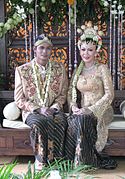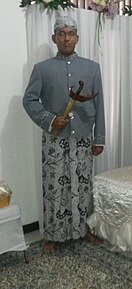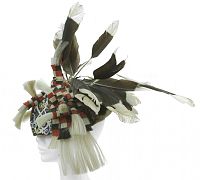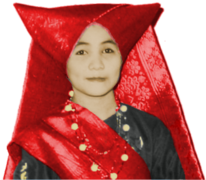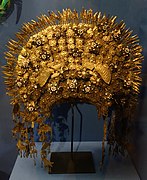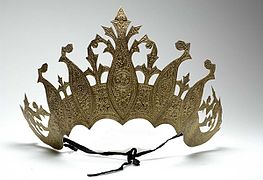|
National costume of Indonesia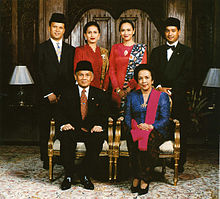  The national costume of Indonesia (Indonesian: Pakaian Nasional Indonesia) is the national attire that represents the Republic of Indonesia. It is derived from Indonesian culture and Indonesian traditional textile traditions. Today the most widely recognized Indonesian national attires include batik[1] and kebaya, although originally those attires mainly belong within the island of Java and Bali, most prominently within Javanese, Sundanese and Balinese culture.[2] Since Java has been the political and population center of Indonesia, folk attire from the island has become elevated into national status. 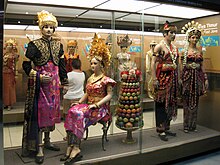 As a multi-diverse country, Indonesia having more than 30 provinces, each has its own representation of traditional attire and dress from each province with its own unique and distinguished designs. National attires are worn during official occasions as well as traditional ceremonies. The most obvious display of Indonesian national attires can be seen by the type of attires worn by the President of Indonesia and the Indonesian first lady in many and different types of occasions and settings, and also worn by Indonesian diplomatic officials during gala dinners. Traditional weddings and formal ceremonies in Indonesia are important occasions in the country where the wear of Indonesia national attires are absolutely visible ranging from traditional to modern attires different from each region they are representing. National attiresBatik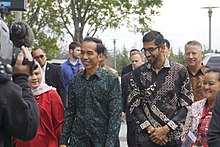 Batik is a cloth that is traditionally made using a manual wax-resist dyeing technique to form intricate patterns. Traditionally batik cloth is a large piece of intricately decorated cloth used by Javanese women as kemben or torso wrap. Batik cloth were wrapped around the hips with multiple folds in front called wiron, while the upper torso wear kebaya fitted dress. Traditionally for men, the edge of batik cloth also can be sewn together to make a tubular cloth as sarong, or wrapped around hips as kain in fashion similar to women's. Later for men, the batik cloth also sewn and made into contemporary batik men's shirt. Batik is recognized as one of the important identity of Indonesian culture. UNESCO designated Indonesian batik as a Masterpiece of Oral and Intangible Heritage of Humanity on October 2, 2009. As part of the acknowledgment, UNESCO insisted that Indonesia preserve their heritage.[3] Batik shirts, which are commonly worn by men in Indonesia (especially in Java), are usually worn during formal occasions; such as attending weddings, traditional ceremonies, formal meetings, communal gatherings, etc. Sometimes men who wear batik shirt usually also wearing a songkok or peci cap to make it more formal in a traditional way. Batik shirts have two types of cuts: long sleeves for formal occasions, and short sleeves for casual to semi-formal occasions. Batik shirt or blouse are also available for women. Batik pattern differs from region to region, especially across Java and other islands, and have their own motifs or patterns unique to respective local tradition and culture. Kebaya The kebaya is the national attire of women from Indonesia, although it is more accurately endemic to the Javanese, Sundanese and Balinese peoples.[2] It is sometimes made from sheer material such as silk, thin cotton or semi-transparent nylon or polyester, adorned with brocade or floral pattern embroidery. Kebaya is usually worn with a sarong or batik kain panjang, or other traditional woven garment such as ikat, songket with a colorful motif. The earliest form of kebaya originates in the court of the Javanese Majapahit Kingdom as a means to blend the existing female Kemban, torso wrap of the aristocratic women to be more modest and acceptable to the newly adopted Islam religion. Aceh, Riau and Johor kingdoms and Northern Sumatra adopted the Javanese style kebaya as a means of social expression of status with the more alus or refined Javanese overlords.[4] Kebaya is usually worn during official national events by the Indonesian first lady, wives of Indonesian diplomats, and Indonesian women in general. It also worn by Indonesian women attending traditional ceremonies and weddings. In Kartini day on 21 April Indonesian women usually wear kebaya to celebrate and honor the Indonesian women emancipation heroine. During Balinese traditional ceremonies, Balinese women wore colorful Balinese style kebaya with songket Bali. Peci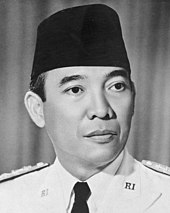 The Peci, also known as songkok or kopiah, is a cap traditionally worn by male Muslims in the Indonesian archipelago. It is quite similar to the Turkish-Egyptian fez. In Indonesia, the black velvet peci has become the national headdress with secular nationalist connotations made popular by Sukarno.[5] A number of Indonesian nationalist movement activists in the early 20th century, such as Sukarno, Muhammad Hatta and Agus Salim, wore a peci to convey their nationalistic sentiments and to demonstrate their Indonesian identity. Indonesian male presidents always wear a peci as part of their official presidential attire. Since then, the black velvet peci is approved to be the national head-dress for Indonesian men. It is worn all over Indonesia, especially by government officials and men (usually Muslim men) throughout the country. The peci is usually worn with batik shirt or western-style suits by men in Indonesia for those attending formal occasions. It is also commonly worn during Islamic religious occasions. Senior citizen Muslim men across Indonesia — usually in Jakarta who identify themselves as native Betawi people, also use this peci on an everyday basis. It is also a traditional head-dress of the Betawi people and also other ethnic groups, especially in the western parts of Indonesia which are mainly Muslims. Regional attiresOther than the national attires, each of the provinces of Indonesia — more precisely every ethnic group of Indonesia, have their own regional traditional attires. These regional attires in Indonesian is called baju adat or pakaian adat, and derived from traditional Indonesian textile traditions and crafts. The best chance to see an example of Indonesian traditional attires is by attending a traditional wedding ceremony. The traditional attires differs according to its function and occasion; the most elaborate and extravagant ones usually reserved for bride and groom only, while a more common traditional attires are worn by local people during traditional ceremonies. Some examples of Indonesian regional attires (baju adat) are: Textiles Stamped batik, the design of which takes months to create; double weave ikat from the islands of Nusa Tenggara, silk Bugis sarong from Sulawesi, gold-painted Balinese prada fabric; shimmering kain songket from Palembang utilizing silver and gold metallic threads weft in woven cotton or silk ikat; and tapis weavings from Lampung. Weavings from the 34 provinces utilize different materials, methods, colors and designs. Primarily formed on back looms, weeks or months are spent creating intricate designs for everyday use or ceremonial wear. These weavings are primarily known by the different techniques that are used to create the distinctive designs. The symbolism of the various ethnic groups is evident in the variety of textiles. Color, shapes and their arrangements all have special meanings. Certain designs can only be worn by women or men, or only by the members of the royal family or nobility. Special textiles are worn or exchanged in life cycle or rights of passage ceremonies celebrating birth, circumcision, puberty, marriage, childbearing and death. Textiles play an important role in many traditional events and ceremonies. Written records dating to the fourteenth century document the importance of textiles in the social and religious lives of Indonesians. The highly distinctive traditional dress, or pakaian adat, best shows the diversity of uses of textiles throughout the archipelago. The even more elaborate bridal dress displays the best of each province's textile and ornamental jewelry traditions. 
ClothingIn the Indonesian archipelago, the most basic and traditional way to wear a traditional garments, is just by wrapping the traditional fabrics around the hips as kain or sarong and secure it; and for women, wrapping the torso with kemben (torso wrap). This practice can still be found in Java, Bali, and Nusa Tenggara. Nevertheless, the development and the expansion of sewing and clothing techniques has creates tailored shirts for men and women. Tight fitting women's kebaya and tailored batik shirt for men is the example of traditional clothing that today transcends ethnic boundaries in Indonesia and has become a national attire. Other than those two, there are a number of tailored shirts or clothing developed in Indonesia. Men
Women
HeadgearEach different region, island, tribe, and culture in Indonesia has its own head-dress/head-gear worn traditionally by the particular people of the area. The peci or songkok is the national formal head-dress worn by men all over Indonesia, usually worn by government officials. Men's head-dress are usually made of traditional fabrics, while women's head-dress often consists of metal jewelries sometimes decorated with floral arrangements. Examples of different head-dress across the country are: Men
Women
See alsoReferences
|
